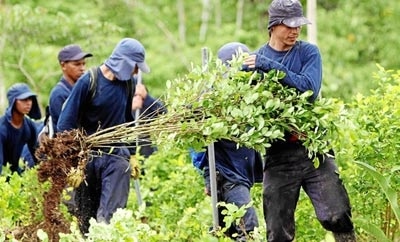The number of hectares of coca manually eradicated in Colombia fell to its lowest level in 2012 since the manual eradication project began in 2005, as the program faces budget pressures, opposition from growers, and changing cultivation patterns.
Over the year, 30,000 hectares were manually eradicated, 4,000 less than 2011. The total was 2,000 hectares less than the first year of organized manual eradication in 2005, and 66,000 less than the 2008 peak, reported El Tiempo.
InSight Crime Analysis
Experts have offered various opinions on why the manual eradication program seems to be shrinking, and the truth is likely to be found in a combination of these theories.
The most obvious reason is the drastic cuts in the program’s budget. In 2010, the budget stood at approximately $61 million, while by 2012 that had fallen to just over $29 million.
The director of the counter-illegal crops program of the Territorial Consolidation Unit, Ivan Fernandez, blamed the drop on the trend towards increasingly small and concealed plantations where coca often grows side by side with food crops, making detection and eradication more difficult and expensive.
Another recent development that has slowed manual eradication attempts has been the use of blockades by coca growers to deny eradication teams access to coca plantations, although security forces are adapting to this by using smaller teams that can cover more territory at the same time.
The US State Department, meanwhile, attributed the decline to security concerns and a reorganization of the Consolidation Unit.
However, anti-narcotics police consulted by El Tiempo had a different, and likely oversimplified theory — that less crops are being eradicated because less crops are being planted.
Manual coca eradication has been touted as an alternative to the controversial US-driven aerial eradication program. The Colombian government has faced heavy criticism aboard and fierce protests at home over the spraying of pesticides, which critics say is detrimental to the environment and human health, and is carried out indiscriminately.
However, while the number of hectares eradicated manually has been declining, the number of hectares aerially sprayed — 100,549 in 2012 — has remained fairly consistent since 2009, although it remains well below the 2006 high of 172,000 hectares, according to the US State Department.

